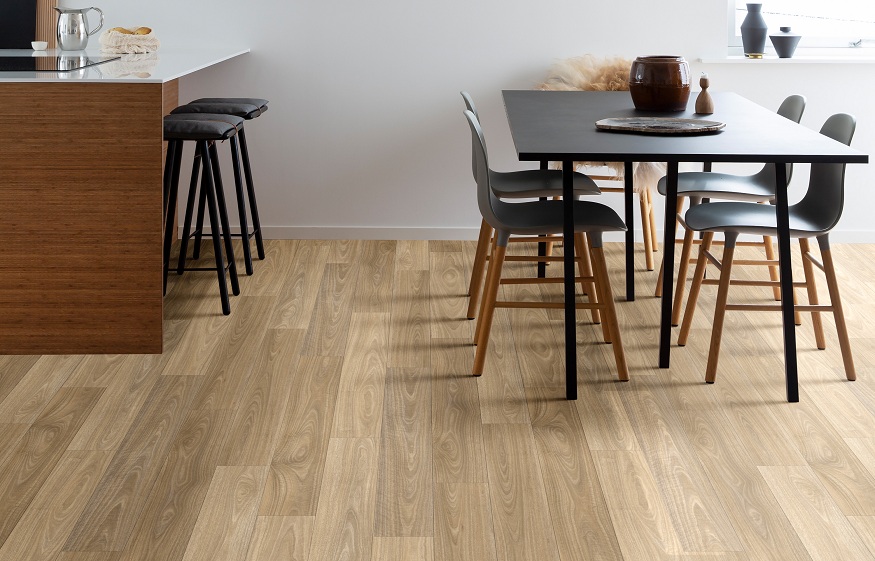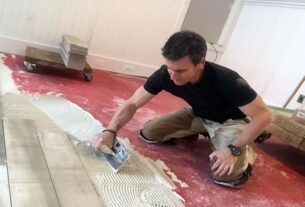In reality, the hybrid flooring category consists of two unique yet comparable kinds of flooring: WPC hybrid and SPC hybrid. Despite the fact that they share the moniker ‘Hybrid,’ it is essential to see them as distinct goods.
Here, we’ll compare SPC hybrid and WPC hybrid flooring in detail to help you pick which material best suits your requirements.
What Exactly is WPC Flooring?
The core of WPC (Wood Plastic/ Polymer Composite) flooring normally consists of:
- Calcium Carbonate (Limestone Powder)
- Wood-like or true wood products include wood flour or bamboo flour
- Polyvinyl chloride (PVC) as the binder
- UV Stabilizer
- An agent for causing foaming
The back of the product is then covered with an underlay (foam or rubber), followed by a 1.5mm layer of vinyl, a vinyl image film, and a Polyurethane PVC Wear Layer.
Around eight years ago, WPC flooring were introduced to the Australian market for the first time. Originally referred to as “wood-plastic composite” because to the wood-like components contained in its composition, WPC floors were first dubbed Prior to the introduction of SPC, WPC flooring never really gained popularity in Australia as a substitute for numerous rafted flooring solutions. Then both items were categorised as “Hybrid,” and the difference between them was often forgotten.
WPC flooring is waterproof and has the same wear layer and image layer as vinyl plank flooring.
What Exactly is SPC Flooring?
The core of SPC (Stone Plastic/Polymer Composite) flooring is normally constructed of:
- At least 80% Calcium Carbonate (Limestone Powder)
- Polyvinyl chloride (PVC) as the binding agent
- UV Stabilizer
In addition, foam or rubber underlay has been put to the rear of this product. The core is then bonded directly to a vinyl picture film using the same Polyurethane PVC. Contrary to the WPC, there is no requirement for a vinyl layer between the Core and Picture Film.
Three to four years after WPC flooring was introduced to the market, SPC hybrid flooring swiftly gained popularity because to its durability, reliability, and quality. In the last three years, SPC Hybrid Flooring has been the most popular kind of flooring. Because it lacks Wood and Bamboo Flour and the Foaming Agent found in WPC, its composition is more stable and resistant to temperature fluctuations.
Similar to WPC flooring, SPC flooring is waterproof and has the same wear layer and image film as vinyl plank flooring.
What is the primary difference between SPC hybrid flooring and WPC hybrid flooring?
The primary distinction between SPC and WPC hybrid flooring is that the core of WPC flooring contains a foaming agent. This causes small microbubbles of air to permeate the core of WPC hybrid flooring.
Which Hybrid Flooring Is More Expensive: WPC or SPC?
In terms of the price difference between WPC and SPC hybrid flooring, they are often equivalent. The production of WPC hybrid flooring is more labor-intensive due to the extra components and procedures needed. Because it is a solid core product, more Calcium Carbonate is used in the creation of SPC flooring, which increases its product intensity.
Which Flooring Is Denser: WPC or SPC?
We often get inquiries concerning the thickness of hybrid flooring. The general misconception is that more thickness is better. The WPC and SPC categories must be evaluated independently, since a 6mm SPC floor will be stronger than a 9mm WPC floor!
Despite the fact that a portion of WPC flooring may be thicker than an SPC plank, it will often lack the strength of SPC flooring owing to the foaming agent employed in the product’s core. The simplest way to visualise this is by comparing the WPC Floor to a “Aero Bar” and the SPC to “Full Cream Dairy Milk” chocolate. The Full Block of Aero bar weighs 115 grammes, whilst the Solid Chocolate counterpart in the same Volume is 180 grammes.
Despite the fact that they are both constructed of extremely comparable components, the Full Block of Aero bar weighs less. Air was the only distinction between these two goods.
Hybrid Flooring is comparable. Most WPC boards must be 8mm or thicker to compensate for the aeration inside their core. SPC hybrid flooring may be as thin as 6mm and is stronger than 8mm thick WPC flooring.
For SPC flooring, the optimal thickness is often between 6mm and 7mm. This is because, despite SPC’s extreme hardness, it may be rather fragile in thinner formats. In addition, if the product is exposed to direct sunlight for an extended period of time while having a lighter core, it may become somewhat unstable.
A hybrid of 7mm will normally have a core weight that is 50 percent more than a hybrid of 5.5mm from the same manufacturer with the same core weight per cubic metre. This offers the product significantly stronger joints (every half millimetre makes a difference) and increases its stability and resilience to the elements.
Is Denser Hybrid Superior?
In general, this is true, but there are certain unanticipated disadvantages to consider about the thickness of a hybrid. While a thicker product provides better strength and stability, how much extra is necessary? Transporting a product with a thickness more than seven millimetres is too costly. If a 7mm Hybrid weighs 10kg per square metre, for instance, a 9mm Hybrid would normally weigh 13-14 kg per square metre.
Therefore, the cost-benefit ratio must be considered: is the additional security above and above what is necessary worthwhile? However, heavier Hybrids rest more securely on the floor, since the additional weight creates friction with the underlay and prevents movement in the flooring raft.
We would be happy to assist you in weighing the benefits and drawbacks of hybrid flooring and selecting the best option for your house.
For any rafted (Hybrid, Laminate, or Wood) flooring, regardless of thickness, it is essential to have a flat subfloor in order to avoid damage to the joints.
Considering Purchasing Hybrid Floors?
Great Option!
Download our Comprehensive Guide to Hybrid Flooring to find out all you need to know to choose the ideal hybrid planks for your room.
How to Distinguish Between WPC and SPC Hybrid Flooring?
To immediately distinguish between WPC and SPC flooring, take up two identically sized, shaped, and lengthened boards. The lighter flooring will be WPC.
An simpler and more straightforward method is to run your finger along an exposed joint. Due of the open-air bubbles in its core that are revealed when the join is contoured into the product, WPC will feel like light grit sandpaper. SPC, however, will feel entirely solid and smooth, even where it has been profiled, since it is solid throughout!
Which is superior, SPC or WPC flooring for commercial applications?
Commercial applications choose SPC flooring with a higher weight. This is because, as a floating floor, it is not attached to the Sub-Floor underneath and may shift when a significant number of people walk on it. If this movement occurs in various directions, a lighter weight floor may be pushed together and generate peaks in certain spots, or it may pull apart at the joints.
We do not advocate WPC or lightweight SPC flooring (5.5mm or less) for any business use. For bigger commercial applications, consider a Hybrid with a minimum thickness of 8mm.
Then why is WPC Hybrid still available?
You may be asking yourself this after reading this. The simple explanation is that WPC is an older technology, and firms have made significant investments in it and must sell their product. A tale may be given to the ignorant that makes WPC seem impressive. It is not that it is awful, but SPC is superior in almost every regard.
As Hybrid gained traction on the Australian market, it quickly became apparent that this was the golden goose, and every provider wanted a piece of the action. The challenge for several providers was that they lacked experience in many flooring categories, and when they sought a point of differentiation, WPC seemed to be the solution in certain circumstances.
During my tenure at Signature Floors, for instance, the Hybrid Development team consisted of myself, one other individual with knowledge in hard flooring (Timber and Laminate), and two individuals with expertise in resilient (Vinyl) flooring. In this procedure, both sides of the table possess knowledge that the other lacks. This prompted us to approach the issue from all angles, and SPC was the obvious solution.
Some businesses lack this cross-pollination of expertise and were unaware of their ignorance. Others had made substantial investments in WPC before to the introduction of SPC and were unable to reverse course without incurring significant financial loss. They often added SPC along the road, but were unable to completely eliminate their WPC inventory.
Do You Have Additional Concerns Regarding SPC or WPC Hybrid Flooring?
If you have any questions, would want to learn more about the benefits and drawbacks of hybrid flooring, or would need more information about WPC or SPC hybrid flooring, please contact our team of flooring specialists, learn more.
One of our knowledgeable flooring specialists would be pleased to assist you during the whole process, assist you in selecting the right flooring type for your requirements, and make purchasing flooring as simple as possible.

